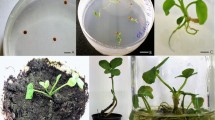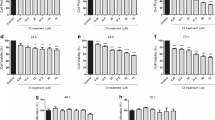Summary
Many naturally occurring substances of plant origin ingested in human diet, exhibit anticarcinogenic and antimutagenic effects. One of the active phytochemical which shows the active anticarcinogenic role is Piper longum Linn. (Pl). Pl is widely used in ayurvedic industry due to its property in healing some of the bodily ailments. Despite being known for the antioxidant, antimicrobial and anticarcinogenic effects, its relation to brain and its tumour development is still scarce. Hence, the experimental glioma model was developed in rats using C6 glioma cells and the effect of Pl was evaluated in the brain tissue of experimental group of rats. From the study, the glioma induced animals showed an increased level of lipid peroxides (LPO), tissue marker enzymes lactate dehydrogenase (LDH), creatine kinase (CK), 5′nucleotidase (5′ND) and acetylcholine esterase (AChE). But Pl treatment (20 mg/kg body weight) significantly attenuated these alterations thereby showing potent anticancer effect in glioma induced rats. In addition, the anticarcinogenic effect of Pl was confirmed by microscopic analysis and the restoration of increased lipids and protein bound carbohydrates (PBCs) in the brain tissue of glioma induced rats. Hence our results implicate a major role for Pl in preventing the cancer development in the experimental glioma model.




Similar content being viewed by others
References
Mamelak AN, Jacoby DB (2007) Targeted delivery of antitumoral therapy to glioma and other malignancies with synthetic chlorotoxin (TM-601). Expert Opin Drug Deliv 4:175–186
CBTRUS (2004–2005) Statistical Report: Primary Brain Tumors in the United States, 1997–2001. Published by the Central Brain Tumor Registry of the United States
Devasagayam TP, Sainis KB (2002) Immune system and antioxidants, especially those derived from Indian medicinal plants. Indian J Exp Biol 40:639–655
Willett WC (1994) Diet and health: what should we eat? Science 22:532–537
Reddy L, Odhav B, Bhoola KD (2003) Natural products for cancer prevention: a global perspective. Pharmacol Ther 99:1–13
Block G, Patterson B, Subar A (1992) Fruit, vegetables, and cancer prevention: a review of the epidemiological evidence. Nutr Cancer 18:1–29
Reen RK, Singh J (1991) In vitro and in vivo inhibition of pulmonary cytochrome P450 activities by piperine, a major ingredient of piper species. Indian J Exp Biol 29:568–573
Khajuria A, Thusu N, Zutshi U, Bedi KL (1998) Piperine modulation of carcinogen induced oxidative stress in intestinal mucosa. Mol Cell Biochem 189:113–118
Shoba G, Joy D, Joseph T, Majeed M, Rajendran R, Srinivas PS (1998) Influence of piperine on the pharmacokinetics of curcumin in animals and human volunteers. Planta Med 64:353–356
Singh YN (1992) Kava: an overview. J Ethnopharmacol 37:13–45
Virinder SP, Subash CJ, Kirpal SB, Rajani J et al (1997) Phytochemistry of genus Piper. Phytochemistry 46:597–673
Koul IB, Kapil A (1993) Evaluation of the liver protective potential of piperine, an active principle of black and long peppers. Planta Med 59:413–417
Kodera T, Nakagawa T, Kubota T, Kabuto M, Sato K, Kobayashi H (2000) The expression and activation of matrix metalloproteinase-2 in rat brain after implantation of C6 rat glioma cells. J Neurooncol 46:105–114
Ohkawa H, Ohishi N, Yagi K (1979) Assay for lipid peroxidation in animal tissues by thiobarbituric acid reaction. Anal Biochem 95:351–358
Lowry OH, Rosebrough NJ, Farr AL, Randall RJ (1951) Protein measurement with the Folin phenol reagent. J Biol Chem 193:265–275
King J (1965) The dehydrogenase of oxido-reductase-Lactate dehydrogenase. In: Van D (ed) Practical Clinical Enzymology 83–93
Okinaka S, Kumogai H, Ebashi S, Sugita H, Momoi H, Toyokura Y, Fujie Y (1961) Serum creatine phosphokinase activity in progressive muscular dystrophy and neuro muscular diseases. Arch Neurol 4:520–525
Fini C, Ipata PL, Palmerini CA, Floridi A (1983) 5′-nucleotidase from bull seminal plasma. Biochim Biophys Acta 14:405–412
Ellman GL, Courtney KD, Andres VJ, Feather-Stone RM (1961) A new and rapid colorimetric determination of acetylcholinesterase activity. Biochem Pharmacol 7:88–95
Folch J, Lees M, Sloane Stanley GH (1957) A simple method for the isolation and purification of total lipides from animal tissues. J Biol Chem 226:497–509
Parekh AC, Jung DH (1970) Cholesterol determination with ferric acetate-uranium acetate and sulfuric acid-ferrous sulfate reagents. Anal Chem 42:1423–1427
Leffler HH, Mc Dougald CH (1963) Estimation of cholesterol in serum by means of improved technics. Tech Bull Regist Med Technol 33:19–23
Rouser G, Fkeischer S, Yamamoto A (1970) Two dimensional then layer chromatographic separation of polar lipids and determination of phospholipids by phosphorus analysis of spots. Lipids 5:494–496
Rice EW (1970) Triglycerides ("neutral fats") in serum. In Standard Methods of Clinical Chemistry 6: 215-22
Horn WT, Menahan LA (1981) A sensitive method for the determination of free fatty acids in plasma. J Lipid Res 22:377–381
Niebes P (1972) Determination of enzymes and degradation products of glycosaminoglycans metabolism in the serum of healthy and varicose subjects. Clin Chim Acta 42:399–408
Wagner WD (1979) A more sensitive assay discriminating galactosamine and glucosamine in mixtures. Anal Biochem 15:394–396
Winzler RJ (1955) Determination of Serum Glycoproteins. In: Glick D (ed) Methods of Biochemical Analysis 2:279–311
Warren L (1959) The thiobarbituric acid assay of sialic acids. J Biol Chem 234:1971–1975
Cantuti CI, Shukitt-Hale B, Joseph JA (2000) Neurobehavioural aspects of antioxidants in aging. Int J Dev Neurosci 8:367–381
Maxwell SR (1995) Prospects for the use of antioxidant therapies. Drugs 49:345–361
Pompella A, Romani A, Benditti A, Comporti M (1991) Loss of membrane protein thiols and lipid peroxidation of allyl alcohol hepatotoxicity. Biochem Pharmacol 41:1225–1259
Mikhail F, Denissenko K, Annie P, Moon-shong T, Gerd PP (1996) Preferential formation of benzo(a)pyrene adducts at lung cancer mutational hotspots in P53. Science 274:430–432
Dhully JN, Raman PH, Mujumdar AM, Naik SR (1993) Inhibition of lipid peroxidation by piperine during experimental inflammation in rats. Indian J Exp Biol 31:443–445
Srinivasan K (2007) Black pepper and its pungent principle-piperine: a review of diverse physiological effects. Crit Rev Food Sci Nutr 47:735–748
Selvendiran K, Prince Vijeya Singh J, Baba Krishnan K (2003) Cytoprotectiveeffect of piperine against benzo(a)pyrene induced lung cancer with reference to lipid peroxidation and antioxidant system in Swiss albino mice. Fitoterapia 74:109–115
Plaa GL (1997) The Snider Address. A four-decade adventure in experimental liver injury. Drug Metab Rev 29:1–37
Reznick AZ, Witt E, Matsumoto M, Packer L (1992) Vitamin E inhibits protein oxidation in skeletal muscle of resting and exercised rats. Biochem Biophys Res Commun 15:801–806
Anbarasi K, Sabitha KE, Devi CSS (2005) Lactate dehydrogenase isoenzyme patterns upon chronic exposure to cigarette smoke: protective effect of bacoside A. Environ Toxicol Pharmacol 20:345–350
Helmes MH, Modia A, Moneim EL, Moustafae MS, Bale EL, Safinoz MEL (1998) Clinical values of serum LDH, ceruloplasmin and lipid bound sialic acid in monitoring patients with malignant lymphomas. Med Sci Res 26:613–617
Yun K (1980) Early effects of ethylnitrosourea on the LDH isozyme of rat fetal central nervous system. Acta Pathol Jpn 30:389–395
Hara M, Yokota H, Ogashiwa M, Takeuchi K (1981) Biochemical monitoring of postoperative glioma. No To Shinkei 33:505–511
Sadej R, Spychala J, Skladanowski AC (2006) Expression of ecto-50-nucleotidase (eN, CD73) in cell lines from various stages of human melanoma. Melanoma Res 16:213–222
Ujhazy P, Berleth ES, Pietkiewicz JM et al (1996) Evidence for the involvement of ecto-50-nucleotidase (CD73) in drug resistance. Int J Cancer 68:493–500
Spychala J (2000) Tumor-promoting functions of adenosine. Pharmacol Ther 87:161–173
Pellegrina CD, Padovani G, Mainente F et al (2005) Anti-tumor potential of a gallic acid containing phenolic fraction from Oenothera biennis. Cancer Lett 226:17–25
Parkinson FE, Ferguson J, Zamzow CR, Xiong W (2006) Gene expression for enzymes and transporters involved in regulating adenosine and inosine levels in rat forebrain neurons, astrocytes and C6 glioma cells. J Neurosci Res 84:801–808
Ramakrishnan G, Augustine TA, Jagan S, Vinodhkumar R, Devaki T (2007) Effect of silymarin on N-nitrosodiethylamine induced hepatocarcinogenesis in rats. Exp Oncol 29:39–44
Vanisree AJ, Shyamaladevi CS (1998) Effect of therapeutic strategy established by N-acetyl cysteine and vitamin C on the activities of tumour marker enzymes in vitro. Indian J Pharmacol 31:275–278
Volker DL (2003) Assisted dying and end-of-life symptom management. Cancer Nurs 26:392–399
Ludwig HC, Rausch S, Schallock K, Markakis E (1999) Expression of CD 73 (ecto-5′-nucleotidase) in 165 glioblastomas by immunohistochemistry and electronmicroscopic histochemistry. Anticancer Res 19:1747–1752
Salpeter MM (1967) Electron microscope radioautography as a quantitative tool in enzyme cytochemistry. I. The distribution of acetylcholinesterase at motor end plates of a vertebrate twitch muscle. J Cell Biol 32:379–389
Dietschy JM, Turley SD (2001) Cholesterol metabolism in the brain. Curr Opin Lipidol 12:105–112
Stolar MW (1988) Atherosclerosis in diabetes: the role of hyperin sulinemia. Metabolism 37:1–9
Goldstein JL, Hazzard WR, Schrott HG, Bierman EL, Motulsky AG (1973) Hyperlipidemia in coronary heart disease I. Lipid levels in 500 survivors of myocardial infarction. J Clin Invest 52:1533
Yuvaraj S, Premkumar VG, Vijayasarathy K, Gangadaran SG, Sachdanandam P (2007) Ameliorating effect of coenzyme Q10, riboflavin and niacin in tamoxifen-treated postmenopausal breast cancer patients with special reference to lipids and lipoproteins. Clin Biochem 40:623–628
Ramakrishnan G, Elinos-Baez CM, Jagan S, Augustine TA, Kamaraj S, Anandakumar P, Devaki T (2008) Silymarin downregulates COX-2 expression and attenuates hyperlipidemia during NDEA-induced rat hepatocellular carcinoma. Mol Cell Biochem 313:53–61
Tosi MR, Trinchero A, Poerio A, Tugnoli V (2003) Fast NMR evaluation of lipids in human tissues. Ital J Biochem 52:141–144
Holleran AL, Lindenthal B, Aldaghlas TA, Kelleher JK (1998) Effect of tamoxifen on cholesterol synthesis in HepG2 cells and cultured rat hepatocytes. Metabolism 47:1504–1513
Hirayama T, Honda A, Matsuzaki Y, Miyazaki T, Ikegami T, Doy M, Xu G, Lea M, Salen G (2006) Hypercholesterolemia in rats with hepatomas: increased oxysterols accelerate efflux but do not inhibit biosynthesis of cholesterol. Hepatology 44:602–611
Nalini N, Manju V, Menon VP (2006) Effect of spices on lipid metabolism in 1, 2-dimethylhydrazine-induced rat colon carcinogenesis. J Med Food 9:237–245
Liu CL, Yang TL (2003) Sequential changes in serum triglyceride levels during adjuvant tamoxifen therapy in breast cancer patients and the effect of dose reduction. Breast Cancer Res Treat 79:11–16
Lanza-Jacoby S (1984) Sequential changes in the activities of lipoprotein lipase and lipogenic enzymes during tumor growth in rats. Cancer Res 44:5062–5067
Krämer SD, Schütz YB, Wunderli-Allenspach H, Abbott NJ, Begley DJ (2002) Lipids in blood-brain barrier models in vitro II: Influence of glial cells on lipid classes and lipid fatty acids. In Vitro Cell Dev Biol Anim 38:566–71
Tugnoli V, Tosi MR, Tinti A, Trinchero A, Bottura G, Fini G (2001) Characterization of lipids from human brain tissues by multinuclear magnetic resonance spectroscopy. Biopolymers 62:297–306
Kolanjiappan K, Ramachandran CR, Manoharan S (2003) Biochemical changes in tumor tissues of oral cancer patients. Clin Biochem 36:61–65
Selvam S, Nagini S (1995) Administration of the plasticizer di(engl hexyl)phthalate alters glycoconjugate profile. Ind J Physiol Pharmacol 39:252–254
Ebrahim AS, Gobalakrishnan R, Murugesan A, Sakthisekaran D (1995) In vivo effect of vitamin E on serum and tissue glycoprotein levels in perchloroethylene induced cytotoxicity. Mol Cell Biochem 144:13–18
Lipton A, Harvey HA, Delong S, Allegra J, White D, Allegra M, Davidson EA (1979) Glycoproteins and human cancer, circulating levels in cancer serum. Cancer 43:1766–1771
Kennedy RO, Berns G, Moran E, Smyth H, Caroll K, Thomes RD, Brien AO, Fennelly J, Butler M (1991) A critical analysis of the use of sialic acid determination in the diagnosis of malignancy. Cancer Lett 58:91–100
Hynes RO (1978) Cell surface proteins and malignant transformation. Biochem Biophys Acta 458:73–107
Jagetia GC, Nayak V, Vidyasagar MS (1998) Evaluation of the anti-neoplastic activity of Tinospora cordifolia in cultured He La cells. Cancer Lett 127:71–82
Author information
Authors and Affiliations
Corresponding author
Rights and permissions
About this article
Cite this article
Subramanian, U., Poongavanam, S. & Vanisree, A.J. Studies on the neuroprotective role of Piper longum in C6 glioma induced rats. Invest New Drugs 28, 615–623 (2010). https://doi.org/10.1007/s10637-009-9301-1
Received:
Accepted:
Published:
Issue Date:
DOI: https://doi.org/10.1007/s10637-009-9301-1




